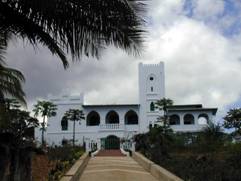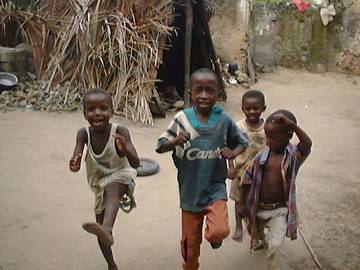I arrived in the Guatemalan mountain town of Todosantos Chuchumantan hoping to improve my Spanish. Some hours after my first lesson, my teacher’s brother was shot dead by a local police officer. The dead man turned out to have been the head of a local gang – the next morning the entire town police force fled in fear of lynching. As the town began the preparations for its annual horse racing fiesta, preparations mainly involving getting fantastically drunk, the infamous Guatemalan army rolled in to keep the order. That weekend, six other people would die, and the host family I was living with would fall into crisis when the father punched his wife in the face. Todosantos was a town of welcoming, curious people, with great pride in their Indigenous Mayan traditions, surrounded by stunning mountains, and full of happy children who would shout, “Hola, Daniel!” whenever I passed their house. Despite the sometimes-terrifying events that took place, it remains my favourite place in Guatemala.
Friday, 31st October 2003: I wake to find my language teacher’s brother dead and my host family distraught at the news. The family are pure indigenous Guatemalans – the rather diminutive mother and four daughters have fantastically long blue-black hair. Everyone in Todosantos wears the same clothes – the traditional blue woven dress for the women; red trousers and white shirt with a huge red, purple or green collar for the men. They speak Spanish to me, and the Mayan alien-sounding “Mam” language to each other. The two youngest daughters, the sweet Juana (age ten) and the bubbly Melissa (age nine) are my main Spanish conversation partners. Without much apparent direction or scolding, the daughters cook meals, tend the log fired stove, wash vast amounts of clothes and blankets, sweep, wash the floors, and weave in their spare time. One magical evening, with everyone else out in the family shop, I watch Juana sit singing to herself while Melissa cooks a simple meal for about seven people.
By Friday afternoon, the three-man marimba bands have begun in earnest, as has the drinking. One of my neighbours is taking part in tomorrow’s fiesta, decked in sashes and a tall hat, he dances as much as his whisky brain will allow. He and his friends drink all night.
That night, an old man drinks himself to death and a young man dies from a knife wound – why, no one knows.
Saturday, 1st November 2003: I wake up at six am – my horse-racing neighbour is unconscious lying face down in the mud. By eight am, his friends have revived him and seated him on a horse – he is led across town to the racetrack.
The Todosantos horse race fiesta is not actually a race at all.  There are no winners, the aim is to ride one’s horse all day back and forth along the two hundred-metre track, taking a drink at each end. At lunchtime there is a break for more drinking, then the race begins afresh in the afternoon. Already by eight am, the riders are already very drunk and many have not slept at all – as the day goes on, their eyes become mirrors and many ride swaying back in their saddle, arms outstretched at their sides. During the race, one man falls from his horse and is trampled to death – many riders finish the day proudly wounded.
There are no winners, the aim is to ride one’s horse all day back and forth along the two hundred-metre track, taking a drink at each end. At lunchtime there is a break for more drinking, then the race begins afresh in the afternoon. Already by eight am, the riders are already very drunk and many have not slept at all – as the day goes on, their eyes become mirrors and many ride swaying back in their saddle, arms outstretched at their sides. During the race, one man falls from his horse and is trampled to death – many riders finish the day proudly wounded.
That night, my friends and I go to the town’s annual fiesta disco: tourists and locals dance in a huge cold hall while a semi circle of twelve assault rifled soldiers watch impassively. Early the next morning, a man lying in the street is killed when the arriving bus runs over his sleeping head.
The remaining deaths discovered that weekend were less well documented – rumour and counter rumour were so widespread it was hard for me to know what was real. Many attendees of the fiesta were making their annual return to the town from their jobs in the United States – stories spread of old scores and inexplicably pregnant wives dealt with violently.
Monday, 3rd November: I wake to find my host family’s house turned black. The husband Augusto has drunkenly punched his wife Dominga, her face is swollen and left eye turned red.
I try to decide what to do. After taking advice from the long-term foreign residents of the town, I decide to move out, to send a message to Augusto and to avoid getting involved in any violence from him. I move out to a “Ladino” (as opposing to Indigenous) family, who drink Pepsi and power their stove with gas instead of logs. The sense of rejoining the cold West is jarring.
I had, and still have, little idea what the correct moral decision would have been in a situation like this. But I was missing the girls too much, the new family I was assigned to weren’t that keen on me – so after a few days I moved back in with Dominga and her daughters. As before, Augusto spent most nights sleeping in the family’s shop further up the hill, so I rarely saw him, but suspect it didn’t even occur to him why I’d left the house for a while.
My last week in Todosantos, I worked in the language school, doing the job of the day manager while he took a break to Lake Atitlan. I shopped among the Todosanteros for bread and light bulbs, organised a big meal for all the foreign residents, and arranged teachers and host families for any new students. It was great to interact with the ever-friendly people of the town on a deeper, less-touristy level. I would have come back to the town to do the language school job full time – the current school co-ordinator was leaving in February – but a month later discovered that they had given it to someone else, and so my travels around the world continued.
Daniel’s travels continue at http://blogs.bootsnall.com/dw

 There are no winners, the aim is to ride one’s horse all day back and forth along the two hundred-metre track, taking a drink at each end. At lunchtime there is a break for more drinking, then the race begins afresh in the afternoon. Already by eight am, the riders are already very drunk and many have not slept at all – as the day goes on, their eyes become mirrors and many ride swaying back in their saddle, arms outstretched at their sides. During the race, one man falls from his horse and is trampled to death – many riders finish the day proudly wounded.
There are no winners, the aim is to ride one’s horse all day back and forth along the two hundred-metre track, taking a drink at each end. At lunchtime there is a break for more drinking, then the race begins afresh in the afternoon. Already by eight am, the riders are already very drunk and many have not slept at all – as the day goes on, their eyes become mirrors and many ride swaying back in their saddle, arms outstretched at their sides. During the race, one man falls from his horse and is trampled to death – many riders finish the day proudly wounded.  The ringing of metal hitting metal in the early evening sunshine rang across the stillness of the Fiord as we moored for the first night on our Norwegian sailing trip. Driving a steel stake into the rock that had a ring attached allowed one to pass a warp through the ring and back to a cleat on the boat – Thus enabling any one to explore the shore easily by just jumping on to the rocks from the bow or stern, have a BBQ or merely to stretch their legs in the evening after a day at sea. The locals used this way of mooring up for the afternoon or night, and this was only possible because of the lack of tides in this part of the world. This was a very pleasant surprise after the difficulties with tides and mooring in the UK.
The ringing of metal hitting metal in the early evening sunshine rang across the stillness of the Fiord as we moored for the first night on our Norwegian sailing trip. Driving a steel stake into the rock that had a ring attached allowed one to pass a warp through the ring and back to a cleat on the boat – Thus enabling any one to explore the shore easily by just jumping on to the rocks from the bow or stern, have a BBQ or merely to stretch their legs in the evening after a day at sea. The locals used this way of mooring up for the afternoon or night, and this was only possible because of the lack of tides in this part of the world. This was a very pleasant surprise after the difficulties with tides and mooring in the UK.  We had set out in ‘Turid’ a 35 ft Halberg Sailing sloop, from Kragero in the south of the country to enjoy a few days break from tackling the stresses and strains of life in London. The Norwegian Skipper had an old 1780’s house overlooking his mooring and was just back from sailing round Greece. David and I have been friends since way back when we were nearly young. He has a wooden Folk boat on the south coast of England and I once had a four berth sailing cruiser moored in Conway. The second piece of luck was that as we boarded the sun came out and for the rest of the trip we had sunshine until about 2130 hours at night with a temperature of 26 degrees Centigrade at sea during the day. People expect it to be cold but in the summer this place can be extremely warm, in fact the week after we left the temperature rose another five degrees.
We had set out in ‘Turid’ a 35 ft Halberg Sailing sloop, from Kragero in the south of the country to enjoy a few days break from tackling the stresses and strains of life in London. The Norwegian Skipper had an old 1780’s house overlooking his mooring and was just back from sailing round Greece. David and I have been friends since way back when we were nearly young. He has a wooden Folk boat on the south coast of England and I once had a four berth sailing cruiser moored in Conway. The second piece of luck was that as we boarded the sun came out and for the rest of the trip we had sunshine until about 2130 hours at night with a temperature of 26 degrees Centigrade at sea during the day. People expect it to be cold but in the summer this place can be extremely warm, in fact the week after we left the temperature rose another five degrees. We started our trip around this wonderful coast with fir trees on the rocks and the houses right on the waterside. Rocks and inlets all around the place, so be careful if you’re not with a local skipper who has a good knowledge of the area. It seemed that everyone in Norway had some sort of boat and they were all making the most of the summer either in their holiday homes right by the sea or on the water.
We started our trip around this wonderful coast with fir trees on the rocks and the houses right on the waterside. Rocks and inlets all around the place, so be careful if you’re not with a local skipper who has a good knowledge of the area. It seemed that everyone in Norway had some sort of boat and they were all making the most of the summer either in their holiday homes right by the sea or on the water. We only docked to take on provisions, but we still had time to visit some of the excellent little ports – Risor, Arendal, Grimstad to name but three. Grimstad was my favourite with some of its wooden houses, in the old town, going back to 1729. I even encountered two Dutch cycle campers that were on a cycle way that took in six north European countries.
We only docked to take on provisions, but we still had time to visit some of the excellent little ports – Risor, Arendal, Grimstad to name but three. Grimstad was my favourite with some of its wooden houses, in the old town, going back to 1729. I even encountered two Dutch cycle campers that were on a cycle way that took in six north European countries. Seeing the Boma, (see photo by the Beetle,) now a fully restored small hotel is even more amazing than any of the photos I had seen, such a dramatic transformation from the derelict building here on my arrival, which was only just nearing completion when I returned for the millennium festivities. It now stands in grounds surrounded by all manner of vibrant vegetation, attracting varied animal life – from butterflies to lizards to the occasional monkey.
Seeing the Boma, (see photo by the Beetle,) now a fully restored small hotel is even more amazing than any of the photos I had seen, such a dramatic transformation from the derelict building here on my arrival, which was only just nearing completion when I returned for the millennium festivities. It now stands in grounds surrounded by all manner of vibrant vegetation, attracting varied animal life – from butterflies to lizards to the occasional monkey.
 We are sorry to say that Mac is not very well, but he is still e-mailing strong and recently sent the Beetle a collection of Mac reminiscences about some of his travels around India in 1992.
We are sorry to say that Mac is not very well, but he is still e-mailing strong and recently sent the Beetle a collection of Mac reminiscences about some of his travels around India in 1992.